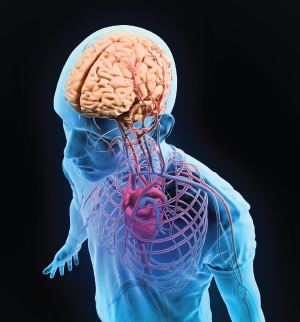
Mopic / shutterstock.com
RETRACTED
Editor’s note: The study this article reported on was retracted by the researchers. Key aspects could not be replicated, and they said, “Most importantly, the findings from behaviour studies and sequencing of microglia isolated from 564Igi autoimmune mice as shown in Figs. 1a, b, d and 3a, b are not substantiated upon further analysis of the original data.”
Insight into the disease mechanisms and cause of brain dysfunction in patients with central nervous system (CNS) lupus suggests a potential new way to treat the common and diverse neuropsychiatric symptoms these patients often exhibit: Target the underlying pathology.
Findings of a new study suggest that type I interferon plays a critical role in stimulating the destruction of neuronal synapses.1 It works through activation of microglia, resident macrophages of the brain, particularly in the hippocampus and frontal cortex regions of the brain. When activated, the microglial cells engulf and destroy neuronal synapses.
“The key finding [of our study] is that interferon alpha from the blood of patients penetrates the brain and activates microglia, leading to synapse loss,” says senior author Michael C. Carroll, PhD, professor of pediatrics and co-director of the Master of Medical Sciences in Immunology Program, Harvard Medical School, and an investigator for the Program in Cellular and Molecular Medicine, Boston Children’s Hospital. This finding opens up the possibility of targeting interferon alpha as a treatment approach for these patients, emphasizes Dr. Carroll, who cites anifrolumab, which is currently in clinical trials, as an example of an antibody that blocks the interferon alpha receptor.
He says preclinical data show the effectiveness of this antibody. “When we treat our lupus mice with a surrogate of the antibody, it shuts off peripheral interferon and prevents microglia activation, synapse loss and the development of neurological symptoms. In my mind, this holds promise as a treatment for patients with lupus and neurological symptoms.”
George C. Tsokos, MD, professor of medicine, Harvard Medical School, chief, Division of Rheumatology, Beth Israel Deaconess Medical School, Boston, agrees. He says that although processes other than the activation of the microglia by interferon alpha may be involved in the development of neuropsychiatric symptoms in lupus patients, the finding of the study strongly supports a closer look at the therapeutic potential of targeting interferon in these patients.
“The study offers a strong rationale to block the receptor for interferon in select patients with neuropsychiatric manifestation,” he says.
Dr. Tsokos says the biggest challenge will be to identify patients with CNS lupus in whom the interferon pathway is the driving force behind the symptoms and treat only those patients.
A Closer Look
Previous research by Dr. Carroll and colleagues identified a role of type 1 interferon in regulating autoreactive B cell frequencies.2 The current study builds on that research by showing that activation of type I interferon in mouse models of lupus was associated with significant neurological deficits and that blocking the type I interferon receptor (IFNAR) prevented these symptoms.1
“Our work in mouse models suggests there may be some shared disease mechanisms in early stages of neurodegenerative diseases and in lupus,” says lead author of the earlier study Allison R. Bialas, PhD, research fellow in the Program in Cellular and Molecular Medicine, Boston Children’s Hospital. “Also, behavioral results indicate that some circuitry involved in cognitive performance, sociability and mood, may be most vulnerable to damage.”
In a commentary on the study, Sarah McGlasson and David Hunt describe well the trajectory of this research and how it led to the current study to determine which cells were responsible for this process and the discovery that microglia were a “prime suspect.”2
“In a series of elegant experiments, the authors demonstrated an association between the observed microglial activation and an increased engulfment of neuronal material, particularly of material from synapses, which form the junctions between two neurons,” McGlasson and Hunt state.2
Along with these findings in mice models of lupus, Dr. Carroll and colleagues observed a similar activation of an interferon response in the microglia in post-mortem examinations of sections of the hippocampus in brains of lupus patients. They say these findings—in both mice models of lupus and post-mortem examinations of lupus patients—support their model, in which the neuropsychiatric manifestations of lupus are the result, in part at least, of the activation of microglia by type I interferon that results in the loss of neuronal synapses.
“While CNS [central nervous system] lupus remains a heterogenous disease with many symptoms and probably many causes, our findings suggest that some CNS lupus patients may benefit from anti-IFNAR treatment,” state the authors in the study conclusion.
Broader Implications
In their commentary, McGlasson and Hunt point to the broader implications of the study that extend to looking at how microglial-mediated synaptic pruning may be involved in brain health and disease. Saying the study’s findings “add to the growing scientific rationale for classifying lupus brain disease according to the molecular mechanisms involved,” McGlasson and Hunt highlight the need for clinical trials of targeted therapies for neurological disease associated with lupus.3
Specifically, they point to the need to find the most effective way to therapeutically modulate type 1 interferon signaling in patients with lupus, particularly with the challenge of developing drugs that can cross the blood–brain barrier. They caution, however, that blocking type 1 interferon signaling in the brain is not without potential risk given the pivotal role of this pathway in host defense and the need for a basal level of interferon signaling to maintain neuronal health.”3
Dr. Tsokos says the biggest challenge will be to identify patients with CNS lupus in whom the interferon pathway is the driving force behind the symptoms & treat only those patients.
For Dr. Carroll, the promising preclinical results of anifrolumab suggest its potential as a targeted therapy in people with CNS lupus. To that end, he and his colleagues suggest that patients with CNS lupus, particularly patients with detectable interferon signatures, be included in further clinical trials of anifrolumab.1
Emphasizing that there is still much work that needs to be done to fully understand how activation of microglia by type I interferon contributes to CNS lupus symptoms, Dr. Bialas underscores the need for clinicians to document and monitor their patients for CNS lupus symptoms.
“I think many lupus patients don’t necessarily think to discuss their neurological symptoms with their rheumatologists, and rheumatologists may not be inclined to ask about them because in most cases there aren’t lupus-specific treatments for these symptoms,” she says. That said, their research indicates new treatments may be coming up in the near future that target type I interferon.
Mary Beth Nierengarten is a freelance medical journalist based in Minneapolis.
References
- Bialas AR, Presumey J, Das A, et al. Microglia-dependent synapse loss in type I interferon-mediated lupus. Nature. 2017 Jun 22;546(7659):539–543.
- Das A, Heesters BA, Bialas A, et al. Follicular dendritic cell activation by TLR ligands promotes autoreactive b cell responses. Immunity. 2017 Jan;46(1):106–119.
- McGlasson S, Hunt D. Neuroinflammation: Synapses pruned in lupus. Nature. 2017 Jun 22;546(7659):482–483.



